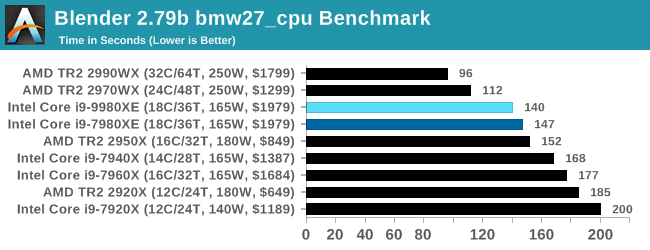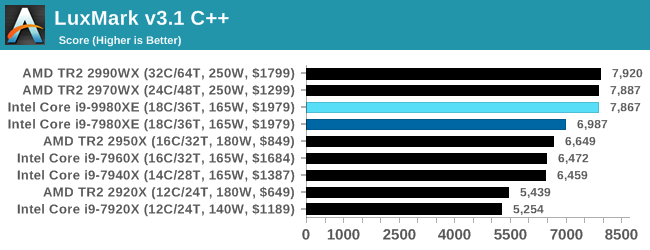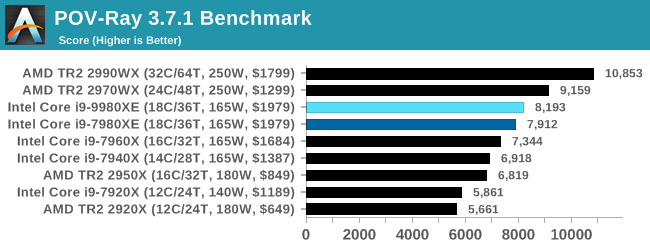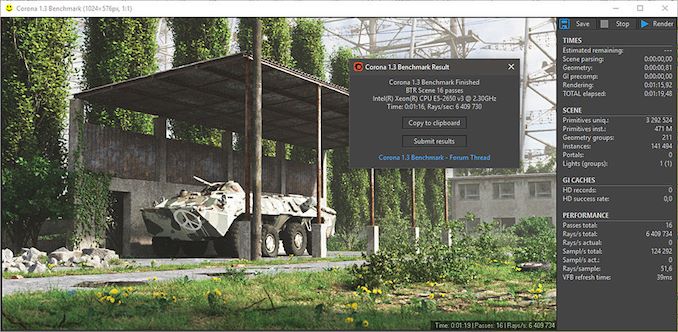The Intel Core i9-9980XE CPU Review: Refresh Until it Hertz
by Ian Cutress on November 13, 2018 9:00 AM ESTHEDT Performance: Rendering Tests
Rendering is often a key target for processor workloads, lending itself to a professional environment. It comes in different formats as well, from 3D rendering through rasterization, such as games, or by ray tracing, and invokes the ability of the software to manage meshes, textures, collisions, aliasing, physics (in animations), and discarding unnecessary work. Most renderers offer CPU code paths, while a few use GPUs and select environments use FPGAs or dedicated ASICs. For big studios however, CPUs are still the hardware of choice.
All of our benchmark results can also be found in our benchmark engine, Bench.
Corona 1.3: Performance Render
An advanced performance based renderer for software such as 3ds Max and Cinema 4D, the Corona benchmark renders a generated scene as a standard under its 1.3 software version. Normally the GUI implementation of the benchmark shows the scene being built, and allows the user to upload the result as a ‘time to complete’.
We got in contact with the developer who gave us a command line version of the benchmark that does a direct output of results. Rather than reporting time, we report the average number of rays per second across six runs, as the performance scaling of a result per unit time is typically visually easier to understand.
The Corona benchmark website can be found at https://corona-renderer.com/benchmark

Corona sees improvement in line with the frequency gain, however the higher core count AMD parts win out here.
Blender 2.79b: 3D Creation Suite
A high profile rendering tool, Blender is open-source allowing for massive amounts of configurability, and is used by a number of high-profile animation studios worldwide. The organization recently released a Blender benchmark package, a couple of weeks after we had narrowed our Blender test for our new suite, however their test can take over an hour. For our results, we run one of the sub-tests in that suite through the command line - a standard ‘bmw27’ scene in CPU only mode, and measure the time to complete the render.
Blender can be downloaded at https://www.blender.org/download/

Similarly with Blender as to Corona: the new Intel Core i9-9980XE performs better than the previous generation 7980XE, but sits behind the higher core count AMD parts.
LuxMark v3.1: LuxRender via Different Code Paths
As stated at the top, there are many different ways to process rendering data: CPU, GPU, Accelerator, and others. On top of that, there are many frameworks and APIs in which to program, depending on how the software will be used. LuxMark, a benchmark developed using the LuxRender engine, offers several different scenes and APIs. *It has been mentioned that LuxMark, since the Spectre/Meltdown patches, is not a great representation of the LuxRender engine. We still use the test as a good example of different code path projections.
In our test, we run the simple ‘Ball’ scene on both the C++ and OpenCL code paths, but in CPU mode. This scene starts with a rough render and slowly improves the quality over two minutes, giving a final result in what is essentially an average ‘kilorays per second’.

Our test here seems to put processors into buckets of performance. In this case, the Core i9-9980XE goes up a bucket.
POV-Ray 3.7.1: Ray Tracing
The Persistence of Vision ray tracing engine is another well-known benchmarking tool, which was in a state of relative hibernation until AMD released its Zen processors, to which suddenly both Intel and AMD were submitting code to the main branch of the open source project. For our test, we use the built-in benchmark for all-cores, called from the command line.
POV-Ray can be downloaded from http://www.povray.org/

POV-Ray is as expected: a performance improvement, but behind the higher core count AMD parts.












143 Comments
View All Comments
TheJian - Friday, November 16, 2018 - link
I stopped reading when I saw 8k with a 1080. Most tests are just pointless, as it would be more interesting with a 1080ti at least or better 2080ti. That would give the chips more room to run when they can to separate the men from the boys so to speak.Vid tests with handbrake stupid too. Does anyone look at the vid after those tests? It would look like crap. Try SLOWER as a setting and lets find out how the chips fare, and bitrates of ~4500-5000 for 1080p. Something I'd actually watch on a 60in+ tv without going blind.
Release groups for AMZN for example release 5000 bitrate L4.1, 5-9 ref frames, SLOWER. etc. Nfo files reveal stuff like this:
cabac=1 / ref=9 / deblock=1:-3:-3 / analyse=0x3:0x133 / me=umh / subme=11 / psy=1 / psy_rd=1.00:0.00 / mixed_ref=1 / me_range=32 / chroma_me=1 / trellis=2 / 8x8dct=1 / cqm=0 / deadzone=21,11 / fast_pskip=0 / chroma_qp_offset=-2 / threads=6 / lookahead_threads=1 / sliced_threads=0 / nr=0 / decimate=0 / interlaced=0 / bluray_compat=0 / constrained_intra=0 / bframes=8 / b_pyramid=2 / b_adapt=2 / b_bias=0 / direct=3 / weightb=1 / open_gop=0 / weightp=2 / keyint=250 / keyint_min=23 / scenecut=40 / intra_refresh=0 / rc=crf / mbtree=0 / crf=17.0 / qcomp=0.60 / qpmin=0 / qpmax=69 / qpstep=4 / ip_ratio=1.40 / pb_ratio=1.30 / aq=3:0.85
More than I'd do, but the point is, SLOWER will give you far better quality (something I could actually stomach watching), without all the black blocks in dark scenes etc. Current 720p releases from nf or amzn have went to crap (700mb files for h264? ROFL). We are talking untouched direct from NF or AMZN. Meaning that is the quality you are watching as a subscriber that is, which is just one of the reasons we cancelled NF (agenda TV was the largest reason to dump them).
If you're going to test at crap settings nobody would watch, might as well kick in quicksync with quality maxed and get better results as MOST people would do if quality wasn't an issue anyway.
option1=value1:option2=value2:tu=1:ref=9:trellis=3 and L4.1 with encoder preset set to QUALITY.
That's a pretty good string for decent quality with QSV. Seems to me you're choosing to turn off AVX/Quicksync so AMD looks better or something. Why would any USER turn off stuff that speeds things up unless quality (guys like me) is an issue? Same with turning off gpu in blender etc. What is the point of a test that NOBODY would do in real life? Who turns off AVX512 in handbrake if you bought a chip to get it? LOL. That tech is a feature you BUY intel for. IF you turn off all the good stuff, the chip becomes a ripoff. But users don't do that :) Same for NV, if you have the ability to use RTX stuff, why would you NOT when a game supports it? To make AMD cards look better? Pffft. To wait for AMD to catch up? Pffft.
I say this as an AMD stock holder :) Most useless review I've seen in a while. Not wasting my time reading much of it. Moving on to better reviews that actually test how we PLAY/WATCH/WORK in the real world. 8K...ROFLMAO. Ryan has been claiming 1440p was norm since 660ti. Then it was 4k not long after for the last 5yrs when nobody was using that, now it's 8k tests with a GTX 1080...ROFLMAO. No wonder I come here once a month or less pretty much and when I do, I'm usually turned off by the tests. Constantly changing what people do (REAL TESTS) to turning stuff off, down, (vid cards at ref speeds instead of OC OOTB settings etc), etc etc...Let's see if we can set up this test in a way nobody would do at home to strike down advantages of anyone competing with AMD. Blah. I'd rather see where both sides REALLY win in ways we USE these products. Turn everything on if it's in the chip, gpu, test, etc and spend MORE time testing resolutions etc we actually USE in practice. 8k...hahaha. Whatever. 13fps?
"Ashes has dropdown options for MSAA, Light Quality, Object Quality, Shading Samples, Shadow Quality, Textures, and separate options for the terrain."
Yeah, I'm out. Dropdown quality is against my religion and useless to me. I'm sure the other tests have issues I'd hate also, no time to waste on junk review tests. Too many other places that don't do this crap. I bought a 1070ti to run MAX settings at 1200p (dell 24in) in everything or throw it to my lower res 22in. If I can't do that, I'll wait for my next card to play game X. Not knocking AMD here, just Anandtech. I'll likely buy a 7nm AMD cpu when they hit, and they have a shot at a 7nm gpu for me too. You guys and tomshardware (heh, you joined) have really went downhill with irrational testing setups. If you're going to do 4k at ultra, why not do them all there? I digress...
spikespiegal - Saturday, November 24, 2018 - link
Just curious, but how many of you AMD fanbois have ever been in a data center or been responsible for adjusting performance on a couple dozen VMware hosts running mixed applications? Oh wait...none. In the mythical world according to AMDs BS dept a Hypervisor / Operating system takes the number of tasks running and divides them by the number of cores running, and you clowns believe it. In the *real world* where we have to deal with really expensive hosts that don't have LED fans in them and run applications adults use we know that's not the truth. Hypervisors and Operating systems schedulers all favor cores that process mixed threads faster, and if you want to argue that please consult with a VMware or Hyper-V engineer the next time you see them in your drive thru. Oh wait...I am a VMware engineer.An i3 8530 costs $200 and literally beats any AMD chip made running stock in dual threaded applications. Seriously....look up the single threaded performance. More cores don't make an application more multithreaded and they don't make contribute to a better desktop experience. I have servers with 30-40% of my CPU resources not being used, and just assigning more cores won't make applications faster. It just ties up my scheduler doing nothing and wastes performance. The only way to get better application efficiency is vertical, and that's higher core performance, and that's nothing I'm seeing AMD bringing to the table.
Michael011 - Wednesday, December 12, 2018 - link
The pricing shows just how greedy Intel has become. It is better to spend your money on a top end AMD Threadripper and motherboard. https://mobdro.io/